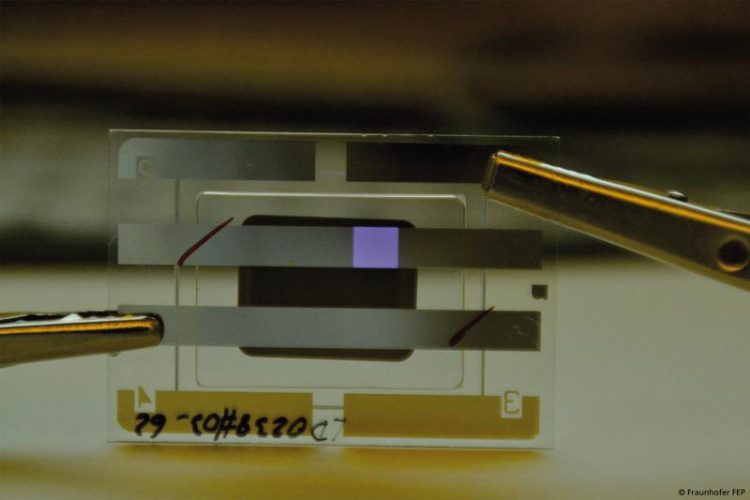Towards future lab-on-chip applications

UV-OLED
Smart and portable medical equipment is essential for fast and easy point-of-care and point-of-use diagnostics. Lab-on-a-chip applications in hand-held devices can help to save time for laboratory medical analysis in emergency scenarios.
The combination of sub-micrometer-thick light emitting devices and photo-detectors with tunable spectral characteristics could play a key role in future sensing chips based on organic electronics.
These applications realize the excitation and detection of fluorescence or phosphorescence in a marker. Even time-resolved measurements are possible. The integration of both, OLED together with organic photodiodes into one chip could be a way to achieve low-cost personal diagnostics outside the laboratory.
At IDW 2014 Fraunhofer FEP presents two different OLED-device concepts: one emitting in the near UV and another one in the green spectral range which both could be integrated to sensor applications.
These two exemplary OLED developments can be used for biomedical and biotechnical sensing in lab-on-chip applications. Near ultra-violet emission from an OLED is demonstrated for bottom- as well as from top-emitting device architectures.
Furthermore, the scientists from Fraunhofer FEP combined a green top-emitting OLED with a thin-film optical filter and thin-film encapsulation so that a sample substance can be brought in proximity to the excitation source. Both developed devices are suitable for large area deposition and integration on silicon-backplanes like wafers as light source for optical excitation to detect fluorescence or phosphorescence signals.
Dr. Michael Thomschke, project leader at Fraunhofer FEP states: “These developments could be incorporated in very small ultra-thin organic devices based on glass, foil or opaque silicon-backplanes. The integration e.g. on silicon-wafers could be very cost-efficient. The corresponding processes allow large area manufacturing as well as devices in the µm scale.”
Later on, such device could be extended with microfluidics or external optics to fit a certain application.
Next to the results for for OLED applications using UV-electroluminescence, Fraunhofer FEP will also present further demonstrators of our latest OLED microdisplays and flexible OLED on different substrates at our booth during the conference.
Besides the exhibition Dr. Michael Thomschke will give a talk „OLED on Silicon for Sensor Applications“ about the latest approaches of OLED devices for lab-on-a-chip applications on Wednesday, December 3, 15:45 – 16:05 in Snow Hall B.
About Fraunhofer FEP:
Fraunhofer Institute for Organic Electronics, Electron Beam and Plasma Technology FEP works on innovative solutions in the fields of vacuum coating, surface treatment and processing with electrons and plasmas as well as organic semiconductors. The core competences electron-beam technology, sputtering and plasma-activated as well as PECVD high-rate coating, technologies for the organic electronic and IC/system design provide the basis for these activities.
Thus Fraunhofer FEP offers a wide range of possibilities for research, development and pilot fabrication, especially for the processing, sterilization, structuring and refining of surfaces as well as OLED microdisplays, organic and inorganic sensors, optical filters and flexible OLED lighting.
Our aim is to develop the innovation potential of the electron beam, plasma technology and organic electronic for new production processes and devices and to make it available for our customers.
Formerly COMEDD (Center for Organics, Materials and Electronic Devices Dresden) with all known activities in organic electronics now is acting as new business units at Fraunhofer FEP, Dresden, Germany.
For further information please contact:
Fraunhofer FEP
Ines Schedwill
Head of Marketing
Maria-Reiche-Str. 2
01109 Dresden/Germany
Tel.: +49 (0) 351/8823-238
Fax: +49 (0) 351/8823-394
e-mail: Ines.Schedwill@comedd.fraunhofer.de
Annett Arnold
Corporate Communications
Winterbergstr. 28
01227 Dresden/Germany
Internet: www.fep.fraunhofer.de
Tel.: +49 (0) 351/2586-452
Fax: +49 (0) 351/2586-105
e-mail: Annett.Arnold@fep.fraunhofer.de
Weitere Informationen:
Media Contact
All latest news from the category: Life Sciences and Chemistry
Articles and reports from the Life Sciences and chemistry area deal with applied and basic research into modern biology, chemistry and human medicine.
Valuable information can be found on a range of life sciences fields including bacteriology, biochemistry, bionics, bioinformatics, biophysics, biotechnology, genetics, geobotany, human biology, marine biology, microbiology, molecular biology, cellular biology, zoology, bioinorganic chemistry, microchemistry and environmental chemistry.
Newest articles

Bringing bio-inspired robots to life
Nebraska researcher Eric Markvicka gets NSF CAREER Award to pursue manufacture of novel materials for soft robotics and stretchable electronics. Engineers are increasingly eager to develop robots that mimic the…

Bella moths use poison to attract mates
Scientists are closer to finding out how. Pyrrolizidine alkaloids are as bitter and toxic as they are hard to pronounce. They’re produced by several different types of plants and are…

AI tool creates ‘synthetic’ images of cells
…for enhanced microscopy analysis. Observing individual cells through microscopes can reveal a range of important cell biological phenomena that frequently play a role in human diseases, but the process of…





















